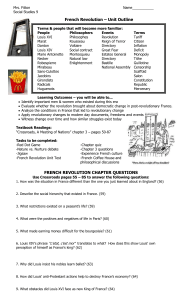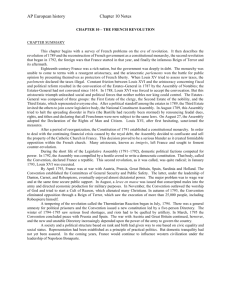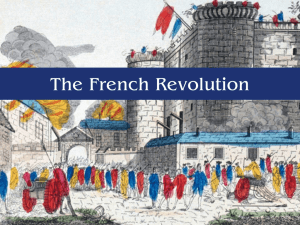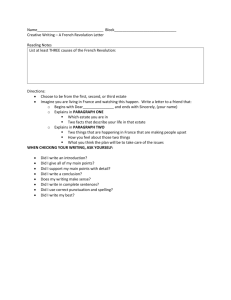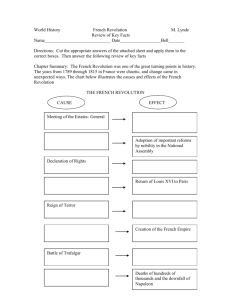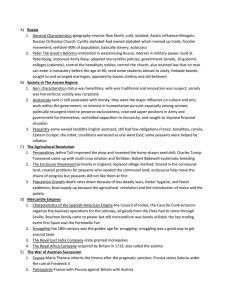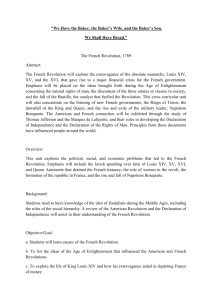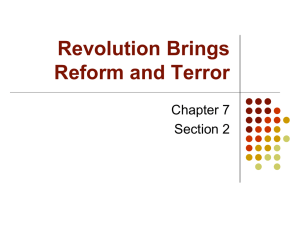French Revolution Phase I
advertisement
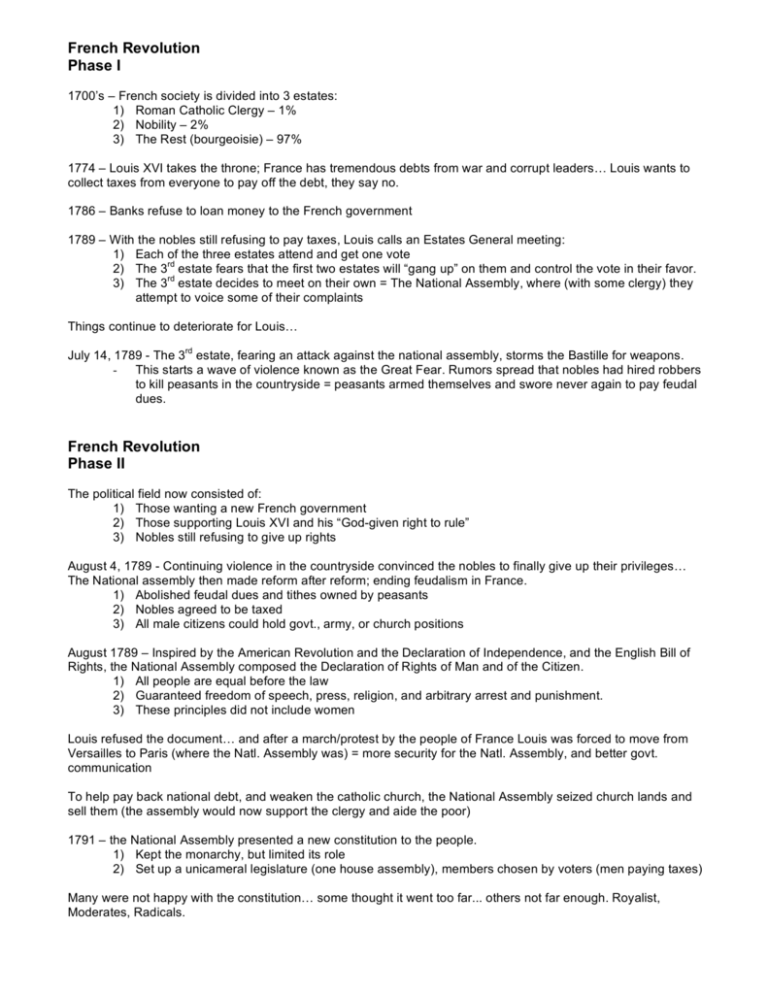
French Revolution Phase I 1700’s – French society is divided into 3 estates: 1) Roman Catholic Clergy – 1% 2) Nobility – 2% 3) The Rest (bourgeoisie) – 97% 1774 – Louis XVI takes the throne; France has tremendous debts from war and corrupt leaders… Louis wants to collect taxes from everyone to pay off the debt, they say no. 1786 – Banks refuse to loan money to the French government 1789 – With the nobles still refusing to pay taxes, Louis calls an Estates General meeting: 1) Each of the three estates attend and get one vote rd 2) The 3 estate fears that the first two estates will “gang up” on them and control the vote in their favor. rd 3) The 3 estate decides to meet on their own = The National Assembly, where (with some clergy) they attempt to voice some of their complaints Things continue to deteriorate for Louis… rd July 14, 1789 - The 3 estate, fearing an attack against the national assembly, storms the Bastille for weapons. - This starts a wave of violence known as the Great Fear. Rumors spread that nobles had hired robbers to kill peasants in the countryside = peasants armed themselves and swore never again to pay feudal dues. French Revolution Phase II The political field now consisted of: 1) Those wanting a new French government 2) Those supporting Louis XVI and his “God-given right to rule” 3) Nobles still refusing to give up rights August 4, 1789 - Continuing violence in the countryside convinced the nobles to finally give up their privileges… The National assembly then made reform after reform; ending feudalism in France. 1) Abolished feudal dues and tithes owned by peasants 2) Nobles agreed to be taxed 3) All male citizens could hold govt., army, or church positions August 1789 – Inspired by the American Revolution and the Declaration of Independence, and the English Bill of Rights, the National Assembly composed the Declaration of Rights of Man and of the Citizen. 1) All people are equal before the law 2) Guaranteed freedom of speech, press, religion, and arbitrary arrest and punishment. 3) These principles did not include women Louis refused the document… and after a march/protest by the people of France Louis was forced to move from Versailles to Paris (where the Natl. Assembly was) = more security for the Natl. Assembly, and better govt. communication To help pay back national debt, and weaken the catholic church, the National Assembly seized church lands and sell them (the assembly would now support the clergy and aide the poor) 1791 – the National Assembly presented a new constitution to the people. 1) Kept the monarchy, but limited its role 2) Set up a unicameral legislature (one house assembly), members chosen by voters (men paying taxes) Many were not happy with the constitution… some thought it went too far... others not far enough. Royalist, Moderates, Radicals. Fearing unrest and revolt, Louis and the royal family flee Paris for Austrian territory (disguised as commoners)… they’re found, arrested, and Louis is forced to recognize the constitution. Other countries took note, and leaders feared revolts in their areas… émigrés fueled the flames… 1792 - Fearing an Austrian attack to restore Louis to power, France declared war… Austria gets support from Prussia and Sardinia Upheaval ensues… food shortages… citizens attack the king’s palace… he flees to the National Assembly… they offer no protection… The Radicals, wanting a Republic, suspend the king’s powers, and disband the National Assembly French Revolution Phase III September 1792 – Prussia takes the major French fort of Verdun = road to Paris is open = Fear grips France… Thousands volunteer to fight = Prussia defeated at Valmy one week later (100 miles away from France) While the battle of Valmy ensued, the National Assembly met and voted France a republic. 1792-95 – The National Assembly meets; 1) Wrote France’s first democratic constitution 2) Every man could vote now… 1792 – Louis is tried and convicted for “conspiring against the liberty of the nation.” 1793 – Louis is beheaded on the guillotine Republican enthusiasm spreads through France Radicals called themselves Jacobins @ this time (defended the revolution) Moderates were Girondists (thought the revolution had gone far enough and wanted to protect the wealthy middle class from radical attacks) 1793 – Monarchs of Great Britain, Netherlands, Spain, Sardinia, Austria, and Prussia, fearing revolutions @ home, joined in an alliance vs. the French Revolutionary govt. France is determined to end monarchies everywhere… to bring “liberty, equality, and fraternity.” Made up of volunteers they are easily defeated 1793 – France adopts a conscription (draft 18-45)… calls it the “peoples war” War is also raging in France between the Jacobins and the Girondists. Jacobins take control… July 1793 – July 1794 = Reign of Terror; Jacobins set out to crush all opposition in France… the Jacobins lose power and the reign of terror ends By mid 1794 many French citizens wanted a restoration of the monarchy 1795 – A new constitution… 1) Only land owning males could vote = wealthy middle class controlled the govt. 2) Set up the “Directory” – an executive council of 5 1795-1799 – The Directory ruled, putting down opposition with the military The Directory made little effort to resolve the growing gap between the rich and poor… and was plagued by corruption within. People now start looking to the French Army to save France from ruin… In comes Napoleon Bonaparte…
